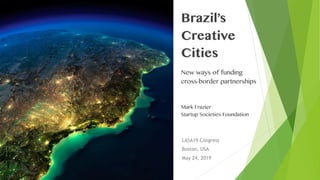Brazil's Creative Cities ŌĆō Self-Funding Partnerships
- 1. BrazilŌĆÖs Creative Cities New ways of funding cross-border partnerships Mark Frazier Startup Societies Foundation LASA19 Congress Boston, USA May 24, 2019
- 2. What weŌĆÖll explore ŌĆō u Near term funding opportunities for Creative Cities u Lasting ways to sustain partnerships for creative endeavors across South America
- 3. Challenge: big disruptions are at hand
- 4. Opportunity: digital tools are leveling the playing field around the world for creative ventures New tools u Affordable telecommunications u Anytime/anywhere learning u Global freelance marketplaces u Online funding platforms Emerging creative economy ŌĆō Billions now can learn, design, and co-create across borders Current economic system ŌĆō National policies limit who can play ŌĆō and determine who wins
- 5. On-demand learning is spreading skills for creative ventures Thousands of online courses from MIT, Harvard, Yale, and other leading universities are offered free of charge
- 6. Jobseekers can access billions of dollars in freelance projects through online markets u Globally, millions of freelance artists, photographers, musicians, writers and web designers have registered in free-to- join online markets for telework u Tens of thousands of Brazilian creative ventures are also now competing for online jobs.
- 7. Creative projects are attracting cross-border volunteers (who commit time and funds)
- 8. Arts and music projects in Brazil have discovered crowdfunding Portuguese language sites: Embolacha, Kickante, Catarse, Sibite
- 9. Brazilian creative ventures are earning income from online product sales
- 10. AirBnbŌĆÖs online platform now promotes creative experiences, including cultural tours, art workshops, and music events
- 12. A near-term path to sustainability: grassroots groups can partner with AirBnbs ŌĆó Local groups can propose public arts projects, music events, festivals, cleanup/fixups, and neighborhood safety campaigns to draw new visitors ŌĆó AirBnb ventures, in return, can share part of their increased earnings with partnering groups as the area improves
- 13. What about long-term sustainability? Grassroots creative ventures can share in land value gains as neighborhoods improve
- 14. Vehicles for sharing the asset gains: land grants and Community Land Trusts Hundreds of universities worldwide have received land grants for sustainabilityŌĆ” Thousands of Community Land Trusts let members enjoy affordable housingŌĆ” StanfordŌĆÖs Tech Park Joint Venture
- 15. Singapore, Hong Kong, and Macau are exemplars of a success-sharing land trust strategy Singapore Macau Hong Kong
- 16. How to supercharge land values: Offer ŌĆ£Special Economic ZoneŌĆØ incentives Zonamerica Free Zone (www.Zonamerica.com) Uruguay has introduced reforms surpassing those of Hong Kong and Singapore, transforming a cow pasture into some of the most valuable land in the Americas (with 10,000+ tech workers)
- 17. How Special Economic Zones sparked ChinaŌĆÖs takeoff In 1979, Shenzhen was a fishing village with a population of under 10,000. There China launched its experimental reforms, with Hong-style low tax and open trade policies. Today, it has become the worldŌĆÖs ŌĆ£Silicon Valley of Hardware,ŌĆØ with more than 11 million residents. Land values have risen more than 50-fold. Now China has more than 100 similar zones of liberalization.
- 18. Liberalized zones are mushrooming Example: a new $10 billion Chinese- funded Special Economic Zone is being launched in TanzaniaMore than 3500 Special Economic Zones exist today in 100+ countries
- 19. Endowment Zones: a lasting way to generate revenue for common benefit Endowment Zones are sites where Community Land Trusts benefit from investor-friendly reforms. With world class reforms, such as cutting taxes and red tape, 5x ŌĆō 50x rises in property values are possible. Shenzhen, Hong Kong, Singapore, and Macau today operate on a land trust model, and are earning billions of dollars from long-term ground leases rather than from selling their land. Proceeds help fund education and social services, as well as ŌĆ£growth dividendŌĆØ payments (in Macau) directly to residents. Endowment Zones can be a source of sustained funding source for Brazilian and South American Creative Cities initiatives.
- 20. Endowment Zones could be used to fund lasting Creative City partnerships A scenario for UNILA ŌĆō the University for Latin America ŌĆō to deal with budget cuts? The university could seek land grant endowments to support cultural linkages via the Conselho do Instituto Latino Americano de Arte, Cultura e Hist├│ria (CONSUNI-ILAACH). With added Special Economic Zone incentives, the land could grow in value ŌĆō and lease revenues could help UNILA promote digital innovations for creative cities throughout the continent. Other beneficiaries of Endowment Zones could include UNIFACENS for Smart City outreach, Brazilian NGOs, associations of creative professionals, and online education/training providers.
- 21. A scenario for Brazilian universities to connect Creative Communities in South America u Seek private and public sector land grants on the model of North American land grant universities (Stanford, Duke, Cornell and 70+ others) u Secure targeted Special Economic Zone incentives (e.g. innovative anticorruption measures to improve the climate for investment, eGoverment fast approvals for investment, reduced taxes, and red tape) u Attract risk-taking private developers to develop the sites on a revenue- sharing basis u Commit shares of the annual ground lease income to fund annual scholarships and fellowships for Creative Cities initiatives u Help seed and spread Endowment Zones for creative industry initiatives throughout Brazil and the Americas
- 22. ChinaŌĆÖs Belt and Road Initiative ŌĆō A New Partnering Opportunity? u China has pledged US$4-8 trillion for a global network of ports, roads, railways and Special Economic Zones. u This ŌĆ£New Silk RoadŌĆØ could fund Endowment Zones and infrastructure projects connecting Creative Cities across Brazil and other South America countries.
- 23. Initial projects already are moving in Brazil
- 24. Conclusion BrazilŌĆÖs Creative Cities and universities can offer innovative models for inclusion, applicable across the continent. These models can deliver near-term revenues and lasting assets for all who seek opportunities in creative economy markets. contact: mark@startupsocieties.org
























